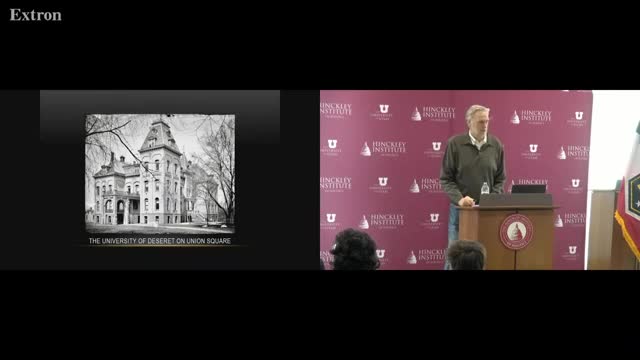University of Utah's historic journey to statehood revealed
November 14, 2024 | Hinckley Institute of Politics, Citizen Journalism , 2024 -2025 Utah Citizen Journalism, Elections, Utah
This article was created by AI summarizing key points discussed. AI makes mistakes, so for full details and context, please refer to the video of the full meeting. Please report any errors so we can fix them. Report an error »

In a recent discussion highlighting the historical evolution of the University of Utah, officials reflected on the institution's origins and its significant role in the state's development. Established as the University of Deseret in the late 19th century, the university initially offered various academic programs, including classical studies and teaching certificates. By 1886, it had begun granting degrees, and student life flourished with literary societies and annual events.
However, the university's early years were marked by external pressures, particularly from the federal government, which sought to curb the influence of the LDS Church and its practices, including polygamy. This tension culminated in the issuance of the 1890 Manifesto by LDS President Wilford Woodruff, which renounced polygamy and was pivotal in Utah's quest for statehood.
In 1892, as part of this transition, the university was renamed the University of Utah. That same year, it expanded its reach by establishing a branch campus in Cedar City, now known as Southern Utah University. The university's founder, John R. Park, played a crucial role in advocating for a new campus location on the east bench of Salt Lake City, recognizing the need for a more suitable site as the institution grew.
Efforts to secure land for the new campus involved navigating complex political landscapes, including multiple drafts of the state constitution to satisfy congressional requirements. Ultimately, Utah achieved statehood in 1896, marking a significant milestone in its history and the university's future. The meeting underscored the importance of these historical developments in shaping the educational landscape of Utah and the enduring legacy of the University of Utah.
However, the university's early years were marked by external pressures, particularly from the federal government, which sought to curb the influence of the LDS Church and its practices, including polygamy. This tension culminated in the issuance of the 1890 Manifesto by LDS President Wilford Woodruff, which renounced polygamy and was pivotal in Utah's quest for statehood.
In 1892, as part of this transition, the university was renamed the University of Utah. That same year, it expanded its reach by establishing a branch campus in Cedar City, now known as Southern Utah University. The university's founder, John R. Park, played a crucial role in advocating for a new campus location on the east bench of Salt Lake City, recognizing the need for a more suitable site as the institution grew.
Efforts to secure land for the new campus involved navigating complex political landscapes, including multiple drafts of the state constitution to satisfy congressional requirements. Ultimately, Utah achieved statehood in 1896, marking a significant milestone in its history and the university's future. The meeting underscored the importance of these historical developments in shaping the educational landscape of Utah and the enduring legacy of the University of Utah.
View full meeting
This article is based on a recent meeting—watch the full video and explore the complete transcript for deeper insights into the discussion.
View full meeting

